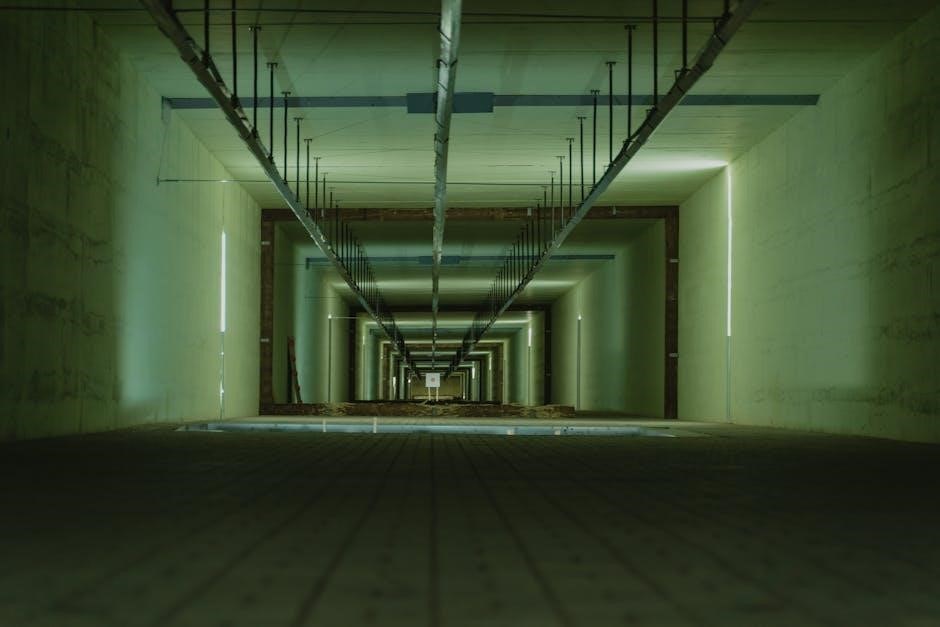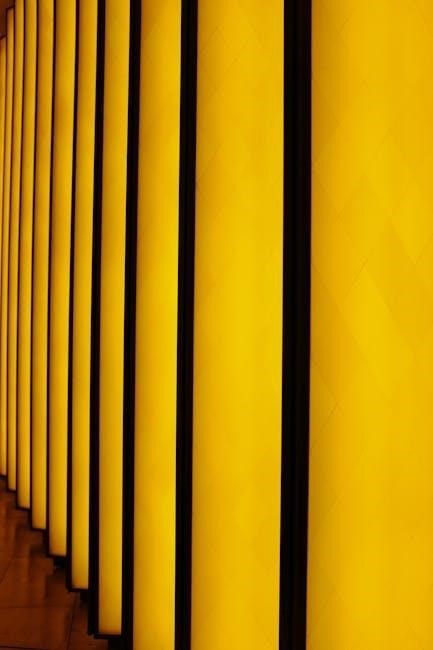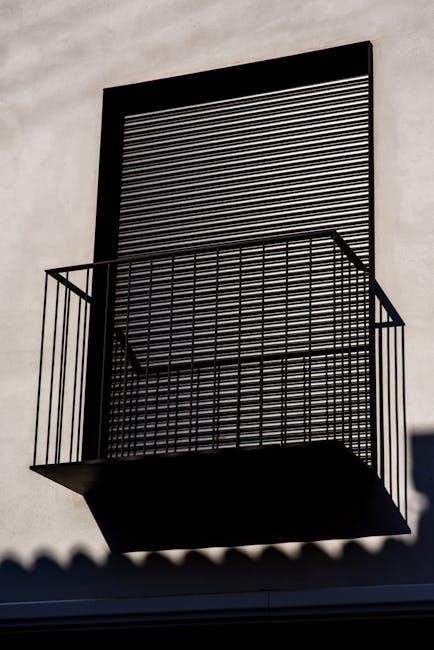
unit 3 parallel and perpendicular lines worksheet with answers pdf
Understanding parallel and perpendicular lines is crucial in geometry, using to solve problems, with transversals and angles playing important roles always․
Definition of Parallel Lines
Parallel lines are lines that lie in the same plane and never intersect, having the same slope․
Using
key concepts
from geometry, parallel lines can be defined as lines that have equal corresponding angles,
with a transversal line intersecting the parallel lines at two distinct points, creating pairs of equal alternate interior angles
and equal alternate exterior angles, which is a fundamental property of parallel lines, and this concept is essential in solving problems
related to parallel lines, and it is also important to note that parallel lines have the same slope, which is a key characteristic
of parallel lines, and this property can be used to determine if two lines are parallel or not, by comparing their slopes,
and if the slopes are equal, then the lines are parallel, which is a crucial concept in geometry and is used extensively
in various mathematical problems and real-world applications, including architecture, engineering, and design,
where parallel lines play a significant role in creating stable and balanced structures, and understanding parallel lines
is essential for solving problems and creating innovative solutions, and it is also important to recognize the relationship
between parallel lines and other geometric concepts, such as angles and transversals, which is critical in developing
a comprehensive understanding of geometry and its applications, and by mastering the concept of parallel lines,
students can develop a strong foundation in geometry and improve their problem-solving skills, which is essential
for success in mathematics and other fields, and it is also important to note that parallel lines are used in various
real-world applications, including art, design, and architecture, where they are used to create balanced and harmonious
compositions, and understanding parallel lines is essential for creating visually appealing and effective designs,
and it is also important to recognize the importance of parallel lines in mathematics and its applications,
and how they are used to solve problems and create innovative solutions, and by understanding parallel lines,
students can develop a deeper appreciation for the beauty and complexity of geometry, and its many applications
in the real world, and it is also important to note that parallel lines are a fundamental concept in geometry,
and are used extensively in various mathematical problems and real-world applications, and understanding parallel
lines is essential for success in mathematics and other fields, and it is also important to recognize the relationship
between parallel lines and other geometric concepts, such as angles and transversals, which is critical in developing
a comprehensive understanding of geometry and its applications, and by mastering the concept of parallel lines,
students can develop a strong foundation in geometry and improve their problem-solving skills, which is essential
for success in mathematics and other fields, and it is also important to note that parallel lines are used in various
real-world applications, including art, design, and architecture, where they are used to create balanced and harmonious
compositions, and understanding parallel lines is essential for creating visually appealing and effective designs,
and it is also important to recognize the importance of parallel lines in mathematics and its applications,
and how they are used to solve problems and create innovative solutions, and by understanding parallel lines,
students can develop a deeper appreciation for the beauty and complexity of geometry, and its many applications
in the real world, with parallel lines playing a significant role in creating stable and balanced structures,
and understanding parallel lines is essential for solving problems and creating innovative solutions,
and it is also important to note that parallel lines are a fundamental concept in geometry, and are used extensively
in various mathematical problems and real-world applications, and understanding parallel lines is essential for success
in mathematics and other fields, and it is also important to recognize the relationship between parallel lines and other
geometric concepts, such as angles and transversals, which is critical in developing a comprehensive understanding
of geometry and its applications, and by mastering the concept of parallel lines, students can develop a strong foundation
in geometry and improve their problem-solving skills, which is essential for success in mathematics and other fields․
Definition of Perpendicular Lines
Perpendicular lines are defined as lines that intersect at a right angle, which is 90 degrees, forming an L shape․
In a
coordinate plane
, perpendicular lines have slopes that are negative reciprocals of each other․

This means that if one line has a slope of m, the other line will have a slope of -1/m, indicating that they are perpendicular․
The concept of perpendicular lines is essential in geometry and is used to solve various problems, including finding the area and perimeter of shapes․

Angles Formed by Parallel and Perpendicular Lines
Parallel and perpendicular lines form various angles, using to solve problems always correctly online․
Corresponding Angles
Corresponding angles are angles that are in the same relative position in two different intersections, formed by a transversal crossing two lines․ The angles are located in similar or matching corners, and are therefore equal in measure․ This concept is crucial in understanding parallel and perpendicular lines, as it helps to identify the relationships between angles․ Using this concept, students can solve problems involving corresponding angles, and apply it to real-world situations․ The internet provides numerous resources, including worksheets and videos, to help students understand corresponding angles․ By mastering this concept, students can improve their understanding of geometry and develop problem-solving skills․ Corresponding angles are a fundamental concept in geometry, and are used to solve a variety of problems, including those involving parallel and perpendicular lines, and are essential for students to learn․
Alternate Interior Angles
Alternate interior angles are angles that are on opposite sides of a transversal, but inside the two lines it intersects․ These angles are equal in measure when the two lines are parallel, and are used to determine if two lines are parallel or not․ The internet provides many resources, including worksheets and videos, to help students understand alternate interior angles․ By studying alternate interior angles, students can develop problem-solving skills and improve their understanding of geometry․ Alternate interior angles are a key concept in geometry, and are essential for students to learn in order to solve problems involving parallel and perpendicular lines․ Using online resources, students can practice solving problems involving alternate interior angles, and apply this concept to real-world situations, making it a fundamental part of their geometry education, with many practical applications in various fields, including architecture and design․

Transversals and Angles
Transversals intersect lines, creating various angles, using to solve problems always with geometry skills․
Definition of a Transversal
A transversal is a line that intersects two or more lines at different points, creating various angles and relationships between them, using key concepts to solve problems in geometry․
The definition of a transversal is crucial in understanding parallel and perpendicular lines, as it helps to identify corresponding, alternate interior, and alternate exterior angles․
A transversal can intersect two lines at two distinct points, forming a pair of angles that are related to each other, and this relationship is essential in solving problems involving parallel and perpendicular lines․
The concept of a transversal is also used to prove theorems and properties of parallel and perpendicular lines, making it a fundamental concept in geometry and trigonometry, with many applications in mathematics and real-life problems always․
Alternate Exterior Angles
Alternate exterior angles are angles that are located on the exterior sides of two lines, but on opposite sides of a transversal, and are equal in measure if the lines are parallel․
These angles are formed when a transversal intersects two lines, creating pairs of angles that are related to each other․
The alternate exterior angles are supplementary to the corresponding angles, and are used to determine the relationship between two lines, such as whether they are parallel or not․
In a diagram, alternate exterior angles can be identified as the angles that are outside the two lines and on opposite sides of the transversal, and are an important concept in geometry and trigonometry, with many applications in mathematics and real-life problems, using key concepts to solve problems always and correctly․

Consecutive Angles
Consecutive angles are adjacent angles, using
key concepts
to solve problems with transversals always forming consecutive angles․
Consecutive Interior Angles
Consecutive interior angles are angles that are located on the inside of two lines and on the same side of their common transversal, using key concepts to solve problems․
The consecutive interior angles are formed when a transversal intersects two lines, creating pairs of angles that are adjacent to each other․
In the context of parallel and perpendicular lines, consecutive interior angles play a crucial role in determining the relationships between angles․
Understanding consecutive interior angles is essential for solving problems involving parallel and perpendicular lines, as they provide valuable information about the relationships between angles․
By analyzing consecutive interior angles, students can develop a deeper understanding of geometry and improve their problem-solving skills, applying key concepts to real-world problems and scenarios effectively always․
Consecutive Exterior Angles
Consecutive exterior angles are angles located on the outside of two lines and on the same side of their common transversal, forming pairs of adjacent angles;
These angles are supplementary, meaning they add up to 180 degrees, and are used to determine the relationships between angles in parallel and perpendicular lines․
The consecutive exterior angles are formed when a transversal intersects two lines, creating pairs of angles that are adjacent to each other on the outside․
Understanding consecutive exterior angles is essential for solving problems involving parallel and perpendicular lines, as they provide valuable information about the relationships between angles․
By analyzing consecutive exterior angles, students can develop a deeper understanding of geometry, applying key concepts to real-world problems and scenarios, and improving their problem-solving skills effectively always in geometry classes․
Geometry concepts are essential, using
key terms
to solve problems effectively always with ease․
Importance of Understanding Parallel and Perpendicular Lines
Understanding parallel and perpendicular lines is crucial in geometry, as it helps in solving problems related to angles and transversals, using key concepts to find corresponding angles and alternate interior angles․ The ability to identify and work with parallel and perpendicular lines is essential in various fields, including architecture, engineering, and design․ It also helps in developing critical thinking and problem-solving skills, as well as spatial reasoning and visualization․ By mastering parallel and perpendicular lines, students can build a strong foundation in geometry and prepare themselves for more advanced math concepts, including trigonometry and calculus, using online resources and worksheets to practice and reinforce their understanding of these important concepts․
Application of Parallel and Perpendicular Lines
Parallel and perpendicular lines have numerous applications in real-world scenarios, including architecture, engineering, and design․ The concept of parallel lines is used in building design, road construction, and railway tracks, ensuring stability and safety․ Perpendicular lines are used in construction to create right angles, essential for building foundations and frameworks․ Additionally, parallel and perpendicular lines are used in computer graphics, game development, and simulation modeling, allowing for accurate and realistic representations of objects and environments․ Online resources, such as worksheets and tutorials, provide opportunities for students to explore and apply these concepts, developing problem-solving skills and preparing them for careers in fields that rely heavily on geometric principles and spatial reasoning, with practical applications in various industries and everyday life, using geometry to solve problems․